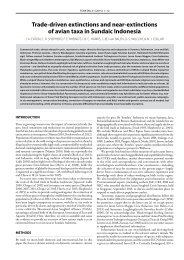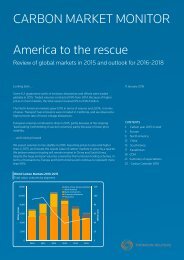Emissions Trading Worldwide
1TbjEHd
1TbjEHd
You also want an ePaper? Increase the reach of your titles
YUMPU automatically turns print PDFs into web optimized ePapers that Google loves.
California Cap-and-Trade Program<br />
Phases and Allocation<br />
<strong>Trading</strong> periods California’s trading period is referred to as a “compliance<br />
period” (see “compliance period” below).<br />
Allowances are allocated and auctioned with calendar year vintages. Some<br />
allowances from future vintages are offered for sale at each auction and may<br />
be traded but not used for compliance until the compliance date for the vintage<br />
year.<br />
allocation Allowances are allocated by benchmarks in each sector. Provisions<br />
for new entrants follow established methodologies for vulnerability to leakage.<br />
The vast majority of industrial allocation is based on production benchmarks<br />
and is updated annually based on verified production data. There is no cap<br />
on the total amount of industrial allocation. Publicly-owned and regulated<br />
investor-owned electric utilities: Receive allowances on behalf<br />
of their ratepayers. Investor-owned utilities must consign the allowances they<br />
receive to state-run auctions. Allowances are also provided to natural gas utilities<br />
on behalf of their ratepayers. All natural gas and electrical utilities must<br />
use the allowance value for ratepayer benefit and for emissions reductions.<br />
Industrial facilities: Receive free allowances for transition assistance and<br />
to prevent leakage. Leakage risk is determined by emissions intensity and trade<br />
exposure. Transition assistance declines with each compliance period. Other<br />
categories of transition assistance are provided for public wholesale water<br />
entities, legacy contract generators, universities, and public service facilities.<br />
The remainder of allowances is auctioned. This will be about 10% of allowances<br />
in the first compliance period, and will increase in subsequent compliance<br />
periods.<br />
compliance period Three calendar years (after first compliance period of two<br />
years). Allowances for emissions of the whole compliance period must be surrendered<br />
by 1 November (or the first business day thereafter) of the year following<br />
the last year of a compliance period.<br />
NB: California’s trading period is referred to as ‘compliance period’ though a portion<br />
of allowances must be submitted for each year’s emissions depending on<br />
the year of the trading/compliance period. First compliance period: 2013–2014<br />
Second compliance period: 2015–2017 Third compliance period: 2018–2020<br />
If the allowances in the reserve are all sold, allowances from future years are<br />
transferred to the reserve and made available for sale.<br />
compliance<br />
MRV Reporting frequency: One year Verification: Emission data reports<br />
and their underlying data require independent third-party verification annually<br />
for all reporters that equal or exceed 25,000 tCO 2e (metric). Other: Reporting<br />
is required for most operators at or above 10,000 tCO 2e (metric). Operators<br />
must implement internal audits, quality assurance and control systems for the<br />
reporting program and the data reported.<br />
Enforcement Penalties may be assessed pursuant to Health and Safety Code<br />
section 38580 (misdemeanor, fines, and possibly imprisonment).<br />
There are separate and substantial penalties for mis- or non-reporting under<br />
the Mandatory GHG Reporting Regulation.<br />
Under the Cap-and-Trade Regulation, if an entity fails to surrender a sufficient<br />
number of compliance instruments to meet its compliance obligation, there<br />
is a separate violation of this article for each required compliance instrument<br />
that has not been surrendered, or otherwise obtained by the Executive Officer.<br />
A separate violation accrues every 45 days after the end of the Untimely<br />
Surrender Period for each required compliance instrument that has not been<br />
surrendered.<br />
Adjustment to Compliance Obligation: Outside of enforcement, there is also an<br />
automatic adjustment to the compliance obligation due equal to the number<br />
of allowances short for that compliance surrender deadline multiplied by four.<br />
A quarter of that amount is retired and the remaining amount is auctioned by<br />
the state.<br />
other information<br />
Institutions involved California Air Resources Board (CARB)<br />
Links with other systems California linked with Québec’s ETS on 1 January<br />
2014.<br />
Flexibility<br />
Banking and borrowing Banking is allowed but the emitter is subject to<br />
a general holding limit. Borrowing across compliance periods is not allowed.<br />
Offsets and Credits Quantitative limit: Up to 8% of each entity’s compliance<br />
obligation. Qualitative Limit: Currently six domestic offset types are<br />
accepted as compliance units originating from projects carried out according<br />
to six ‘protocols’: 1. U.S. forest projects, 2. Urban forest projects, 3. Livestock<br />
projects (methane management), 4. Ozone depleting substances projects, 5.<br />
Mine methane capture (MMC) projects, 6. Rice cultivation projects<br />
PRICE MANAGEMENT PROVISIONS Auction Reserve Floor Price: USD 12.73 in<br />
2016 (EUR 11.60) per allowance. The auction reserve price increases annually<br />
by 5% plus inflation, as measured by the Consumer Price Index. Allowance<br />
Price Containment Reserve: Will be allocated allowances from various<br />
budgets (1% from budget years 2013–2014; 4% from budget years 2015–2017;<br />
and 7% from budget years 2018–2020).<br />
In 2016, the reserve sale administrator can sell accumulated allowances on<br />
a regular basis in three equal price tiers at USD 47.54, 53.49, and 59.43 (EUR<br />
43.36, 48.79 and 52.20). Tier prices increase by 5% plus inflation (as measured<br />
by the Consumer Price Index).<br />
42




